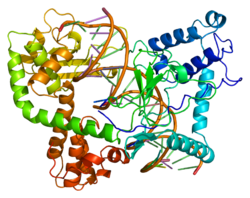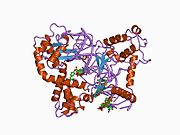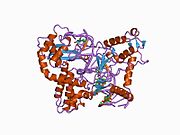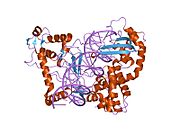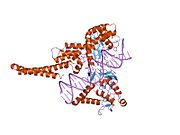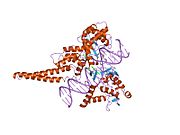DNA topoisomerase 1 is an enzyme that in humans is encoded by the TOP1 gene. It is a DNA topoisomerase, an enzyme that catalyzes the transient breaking and rejoining of a single strand of DNA.
Function
This gene encodes a DNA topoisomerase, an enzyme that controls and alters the topologic states of DNA during transcription. This enzyme catalyzes the transient breaking and rejoining of a single strand of DNA which lets the broken strand rotate around the intact strand, thus altering the topology of DNA. This gene is localized to chromosome 20 and has pseudogenes which reside on chromosomes 1 and 22.
Mechanism
As reviewed by Champoux, the type IB topoisomerases, including TOP1, form a covalent intermediate in which the active site tyrosine becomes attached to the 3' phosphate end of the cleaved strand rather than the 5' phosphate end.
The eukaryotic topoisomerases I were found to nick the DNA with a preference for a sequence of nucleotides that extends from positions -4 to -1 from the nick. The preferred nucleotides in the strand to be cut are 5'-(A/T)(G/C)(A/T)T-3' with the enzyme covalently attached to the -1 T residue, though sometimes a C residue is found at the -1 position.
The TOP1 protein of humans has been subdivided into four regions. The N-terminal 214 amino acids are dispensable for relaxation of supercoiling activity in vitro and there are four nuclear localization signals and sites for interaction with other cellular proteins within the N-terminal domain. The N-terminal domain is followed by a highly conserved, 421 amino acid core domain containing all of the catalytic residues except the active site tyrosine. This is followed by a poorly conserved linker domain of 77 amino acids. Finally there is a 53 amino acid C-terminal domain. The active site Tyr723 is found within the C-terminal domain.
As further summarized by Pommier and by Seol et al., TOP1 breaks the DNA by a transesterification reaction using the active site tyrosine as the nucleophile that attacks the DNA phosphodiester backbone. After the TOP1 covalently attaches to the 3' end of the broken strand, supercoiling of the DNA is relaxed by controlled rotation of DNA about the intact strand. Then the 5' hydroxyl end of the broken DNA strand can reverse the phosphotyrosyl bond, enabling the release of TOP1 and religation of the DNA. The nicking and closing reactions are fast, and about 100 cycles can occur per second.
Inhibition
Main article: Topoisomerase inhibitorThe briefly attached, covalently bonded TOP1-DNA structure at the 3' end of a cleaved DNA single strand is called a TOP1-DNA cleavage complex, or TOP1cc. The TOP1cc is a specific target of TOP1 inhibitors. One of the first inhibitors shown to target TOP1 is irinotecan. Irinotecan is an analogue of the cytotoxic natural alkaloid camptothecin, obtained from the Chinese tree Camptotheca acuminata. Irinotecan is especially effective through its metabolic product SN-38. Irinotecan and SN-38 act by trapping a subset of TOP1-DNA cleavage complexes, those with a guanine +1 in the DNA sequence. One irinotecan or SN-38 molecule stacks against the base pairs flanking the topoisomerase-induced cleavage site and poisons (inactivates) the TOP1 enzyme. The article Camptothecin lists other analogues of camptothecin and the article Topoisomerase inhibitor lists other compounds which inhibit TOP1.
Cancer
Since 1985, TOP1 has been known as a target for the treatment of human cancers. Camptothecin analogues irinotecan and topotecan, which inhibit TOP1, are among the most effective FDA-approved anticancer chemotherapeutic agents used in clinical practice. Higher expression of TOP1 in KRAS mutant non-small cell lung cancer and correlation to survival suggests that TOP1 inhibitors might have increased benefit when administered to treat patients with a KRAS mutant tumor.
Synthetic lethality
Synthetic lethality arises when a combination of deficiencies in the expression of two or more genes leads to cell death, whereas a deficiency in only one of these genes does not. The deficiencies can arise through mutation, epigenetic alteration or by inhibition of a gene's expression.
Irinotecan inactivation of TOP1 appears to be synthetically lethal in combination with deficiencies in expression of some specific DNA repair genes.
Irinotecan inactivation of TOP1 was synthetically lethal with deficient expression of the DNA repair WRN gene in patients with colon cancer. In a 2006 study, 45 patients had colonic tumors with hypermethylated WRN gene promoters (silenced WRN expression), and 43 patients had tumors with unmethylated WRN gene promoters, so that WRN protein expression was high. Irinotecan was more strongly beneficial for patients with hypermethylated WRN promoters (39.4 months survival) than for those with unmethylated WRN promoters (20.7 months survival). The WRN gene promoter is hypermethylated in about 38% of colorectal cancers.
Irinotecan inactivation of TOP1 may be synthetically lethal with deficient expression of DNA repair gene MRE11. A recent study was carried out with 1,264 patients with stage III colon cancer. The patients were treated with a postoperative weekly adjuvant bolus of 5-fluorouracil/leucovorin (FU/LV) or else with irinotecan+FU/LV and were followed up for 8 years. Eleven percent of the tumors were deficient for DNA repair enzyme MRE11 due to a deletion of a string of thymidines in the DNA sequence of the MRE11 gene. The addition of irinotecan to FU/LV in the treatment protocol resulted in MRE11-deficient patients having better long-term disease free survival than patients with wild-type MRE11 (though the effect was small), indicating some degree of synthetic lethality between irinotecan-induced TOP1 inactivation and MRE11 deficiency.
There are a number of pre-clinical studies indicating synthetic lethality of irinotecan with other genetic or epigenetic DNA repair deficiencies common in cancers. For instance, the DNA repair gene ATM is frequently hypermethylated (silenced) in many cancers (see hypermethylation of ATM in cancers). A 2016 study showed that low expression of the ATM protein in gastric cancer cells in vitro and in a mouse model caused increased sensitivity to inactivation by irinotecan compared to cells with high expression of ATM. This indicates synthetic lethality of ATM deficiency with irinotecan-mediated TOP1 deficiency.
Another pre-clinical effort was a screening study to find a compound that would be synthetically lethal with a deficiency of N-myc downstream regulated gene 1 (NDRG1) expression. NDRG1 is a metastasis-suppressor gene in prostate cancer, and appears to have a role in DNA repair. Screening of 3360 compounds revealed that irinotecan-mediated TOP1 deficiency (and one other compound, cetrimonium bromide) exhibit synthetic lethality with NDRG1 deficiency in prostate cancer cells.
DNA repair
Exposure of human HeLA cells to UVB irradiation specifically stimulates the formation of covalent complexes between topoisomerase I and DNA. Topoisomerase I appears to have a direct role in nucleotide excision repair, a process that removes UVB-induced, and other, DNA damages.
Interactions
TOP1 has been shown to interact with:
See also
References
- ^ GRCh38: Ensembl release 89: ENSG00000198900 – Ensembl, May 2017
- ^ GRCm38: Ensembl release 89: ENSMUSG00000070544 – Ensembl, May 2017
- "Human PubMed Reference:". National Center for Biotechnology Information, U.S. National Library of Medicine.
- "Mouse PubMed Reference:". National Center for Biotechnology Information, U.S. National Library of Medicine.
- ^ Pommier Y (2013). "Drugging topoisomerases: lessons and challenges". ACS Chem. Biol. 8 (1): 82–95. doi:10.1021/cb300648v. PMC 3549721. PMID 23259582.
- "Entrez Gene: TOP1 topoisomerase (DNA) I".
- Champoux JJ (2001). "DNA topoisomerases: structure, function, and mechanism". Annu. Rev. Biochem. 70: 369–413. doi:10.1146/annurev.biochem.70.1.369. PMID 11395412.
- Seol Y, Zhang H, Pommier Y, Neuman KC (2012). "A kinetic clutch governs religation by type IB topoisomerases and determines camptothecin sensitivity". Proc. Natl. Acad. Sci. U.S.A. 109 (40): 16125–30. Bibcode:2012PNAS..10916125S. doi:10.1073/pnas.1206480109. PMC 3479559. PMID 22991469.
- ^ Liu YQ, Li WQ, Morris-Natschke SL, Qian K, Yang L, Zhu GX, Wu XB, Chen AL, Zhang SY, Nan X, Lee KH (2015). "Perspectives on biologically active camptothecin derivatives". Med Res Rev. 35 (4): 753–89. doi:10.1002/med.21342. PMC 4465867. PMID 25808858.
- Nagy, Ádám; Pongor, Lőrinc Sándor; Szabó, András; Santarpia, Mariacarmela; Győrffy, Balázs (2017-02-15). "KRAS driven expression signature has prognostic power superior to mutation status in non-small cell lung cancer". International Journal of Cancer. 140 (4): 930–937. doi:10.1002/ijc.30509. ISSN 1097-0215. PMC 5299512. PMID 27859136.
- ^ Agrelo R, Cheng WH, Setien F, Ropero S, Espada J, Fraga MF, Herranz M, Paz MF, Sanchez-Cespedes M, Artiga MJ, Guerrero D, Castells A, von Kobbe C, Bohr VA, Esteller M (2006). "Epigenetic inactivation of the premature aging Werner syndrome gene in human cancer". Proc. Natl. Acad. Sci. U.S.A. 103 (23): 8822–7. Bibcode:2006PNAS..103.8822A. doi:10.1073/pnas.0600645103. PMC 1466544. PMID 16723399.
- ^ Pavelitz T, Renfro L, Foster NR, Caracol A, Welsch P, Lao VV, Grady WB, Niedzwiecki D, Saltz LB, Bertagnolli MM, Goldberg RM, Rabinovitch PS, Emond M, Monnat RJ, Maizels N (2014). "MRE11-deficiency associated with improved long-term disease free survival and overall survival in a subset of stage III colon cancer patients in randomized CALGB 89803 trial". PLOS ONE. 9 (10): e108483. Bibcode:2014PLoSO...9j8483P. doi:10.1371/journal.pone.0108483. PMC 4195600. PMID 25310185.
- ^ Subhash VV, Tan SH, Yeo MS, Yan FL, Peethala PC, Liem N, Krishnan V, Yong WP (2016). "ATM expression predicts Veliparib and Irinotecan sensitivity in gastric cancer by mediating P53 independent regulation of cell cycle and apoptosis". Mol. Cancer Ther. 15 (12): 3087–3096. doi:10.1158/1535-7163.MCT-15-1002. PMID 27638859.
- ^ Wissing MD, Mendonca J, Kim E, Kim E, Shim JS, Kaelber NS, Kant H, Hammers H, Commes T, Van Diest PJ, Liu JO, Kachhap SK (2013). "Identification of cetrimonium bromide and irinotecan as compounds with synthetic lethality against NDRG1 deficient prostate cancer cells". Cancer Biol. Ther. 14 (5): 401–10. doi:10.4161/cbt.23759. PMC 3672184. PMID 23377825.
- Dominick G, Bowman J, Li X, Miller RA, Garcia GG (2016). "mTOR regulates the expression of DNA damage response enzymes in long-lived Snell dwarf, GHRKO, and PAPPA-KO mice". Aging Cell. 16 (1): 52–60. doi:10.1111/acel.12525. PMC 5242303. PMID 27618784.
- ^ Subramanian, D.; Rosenstein, B. S.; Muller, M. T. (1998). "Ultraviolet-induced DNA damage stimulates topoisomerase I-DNA complex formation in vivo: Possible relationship with DNA repair". Cancer Research. 58 (5): 976–84. PMID 9500459.
- Labourier E, Rossi F, Gallouzi IE, Allemand E, Divita G, Tazi J (Jun 1998). "Interaction between the N-terminal domain of human DNA topoisomerase I and the arginine-serine domain of its substrate determines phosphorylation of SF2/ASF splicing factor". Nucleic Acids Research. 26 (12): 2955–62. doi:10.1093/nar/26.12.2955. PMC 147637. PMID 9611241.
- Andersen FF, Tange TØ, Sinnathamby T, Olesen JR, Andersen KE, Westergaard O, Kjems J, Knudsen BR (Sep 2002). "The RNA splicing factor ASF/SF2 inhibits human topoisomerase I mediated DNA relaxation". Journal of Molecular Biology. 322 (4): 677–86. doi:10.1016/s0022-2836(02)00815-x. PMID 12270705.
- ^ Xu L, Yang L, Hashimoto K, Anderson M, Kohlhagen G, Pommier Y, D'Arpa P (2002). "Characterization of BTBD1 and BTBD2, two similar BTB-domain-containing Kelch-like proteins that interact with Topoisomerase I". BMC Genomics. 3: 1. doi:10.1186/1471-2164-3-1. PMC 64781. PMID 11818025.
- Haluska P, Saleem A, Edwards TK, Rubin EH (Apr 1998). "Interaction between the N-terminus of human topoisomerase I and SV40 large T antigen". Nucleic Acids Research. 26 (7): 1841–7. doi:10.1093/nar/26.7.1841. PMC 147454. PMID 9512561.
- Bharti AK, Olson MO, Kufe DW, Rubin EH (Jan 1996). "Identification of a nucleolin binding site in human topoisomerase I". The Journal of Biological Chemistry. 271 (4): 1993–7. doi:10.1074/jbc.271.4.1993. PMID 8567649.
- Gobert C, Skladanowski A, Larsen AK (Aug 1999). "The interaction between p53 and DNA topoisomerase I is regulated differently in cells with wild-type and mutant p53". Proceedings of the National Academy of Sciences of the United States of America. 96 (18): 10355–60. Bibcode:1999PNAS...9610355G. doi:10.1073/pnas.96.18.10355. PMC 17892. PMID 10468612.
- Mao Y, Mehl IR, Muller MT (Feb 2002). "Subnuclear distribution of topoisomerase I is linked to ongoing transcription and p53 status". Proceedings of the National Academy of Sciences of the United States of America. 99 (3): 1235–40. Bibcode:2002PNAS...99.1235M. doi:10.1073/pnas.022631899. PMC 122173. PMID 11805286.
- Mao Y, Sun M, Desai SD, Liu LF (Apr 2000). "SUMO-1 conjugation to topoisomerase I: A possible repair response to topoisomerase-mediated DNA damage". Proceedings of the National Academy of Sciences of the United States of America. 97 (8): 4046–51. Bibcode:2000PNAS...97.4046M. doi:10.1073/pnas.080536597. PMC 18143. PMID 10759568.
External links
- Overview of all the structural information available in the PDB for UniProt: P11387 (DNA topoisomerase 1) at the PDBe-KB.
| PDB gallery | |
|---|---|
|
